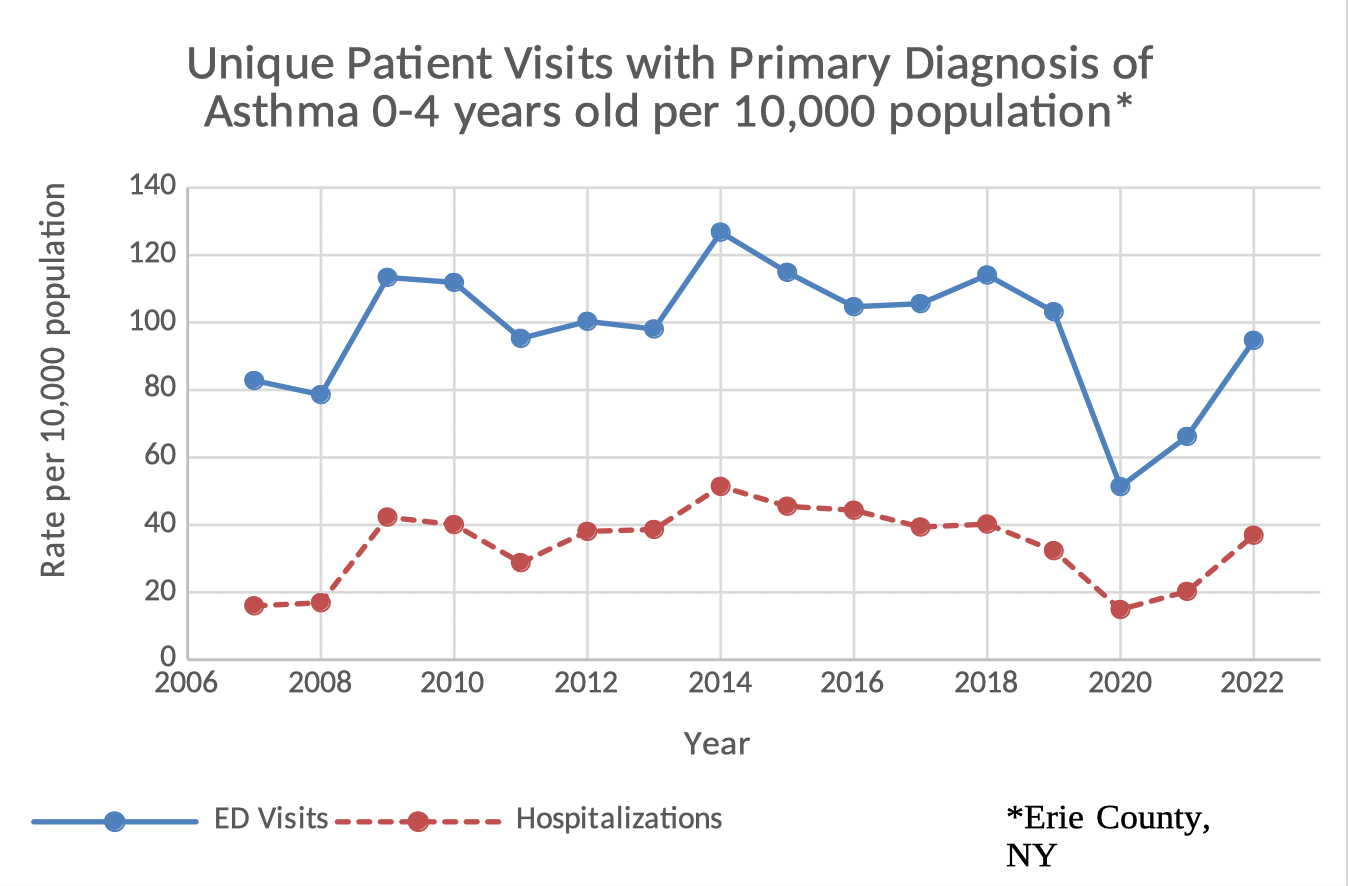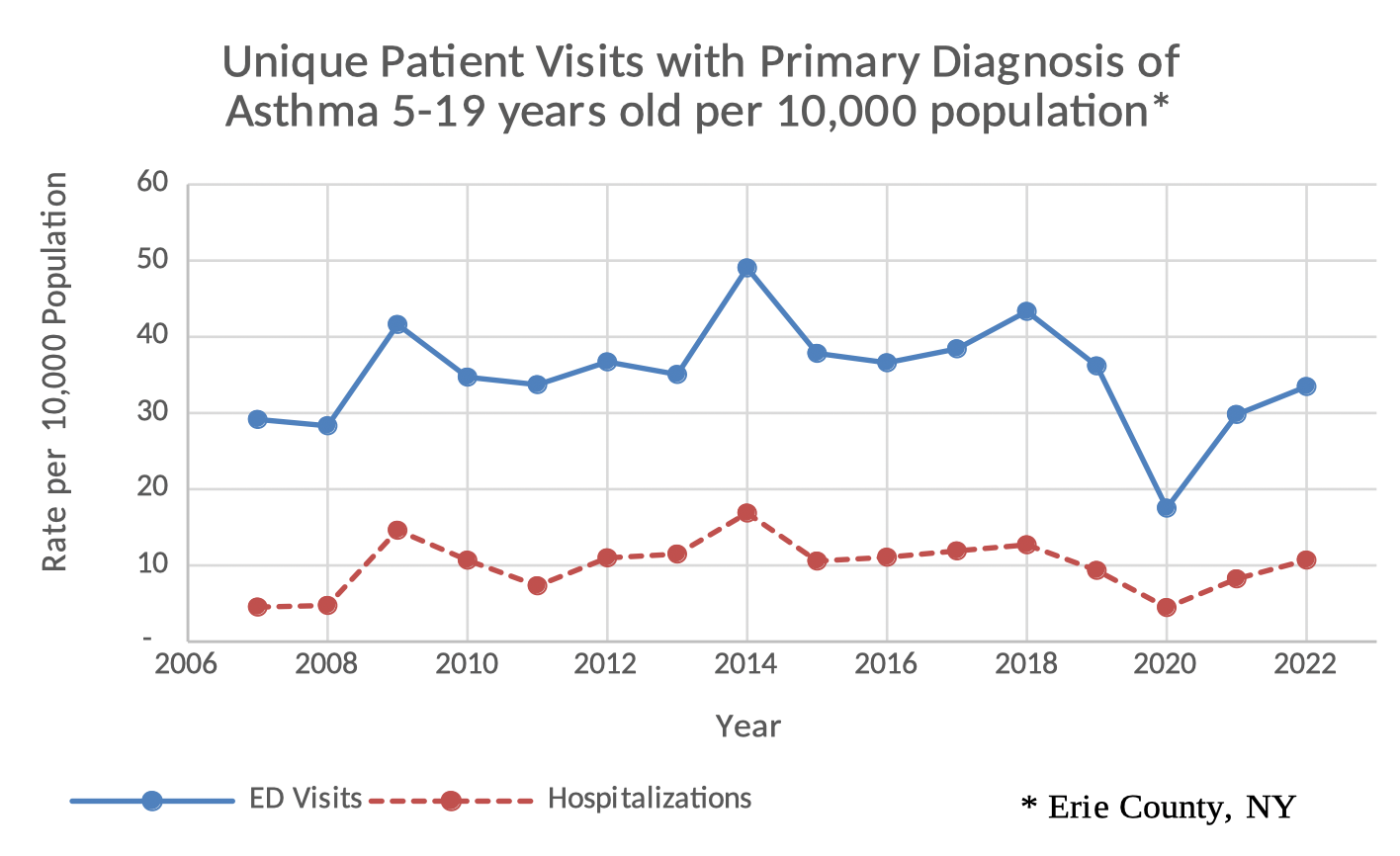Back
Background: Asthma exacerbations triggered by viruses often result in emergency department (ED) visits and hospitalizations. In the last 16 years, the US has experienced several viral pandemics and outbreaks impacting the health of children with asthma. A novel influenza A (H1N1) virus began circulating in 2009 and an outbreak of Enterovirus D68 (EV-D68) infections occurred in 2014. The Severe Acute Respiratory Syndrome Coronavirus 2 (SARS-CoV-2) began spreading around the globe in early 2020 and continues to cause large numbers of infections. Currently, the tri-demic in the fall of 2022 includes infections caused by influenza, coronavirus, and respiratory syncytial virus, and has been sending children to hospitals in the US in records numbers.
Objective: To determine the association between asthma exacerbations resulting in ED visits and hospitalizations, and viral pandemics or outbreaks in our community in the last 16 years.
Design/Methods: We determined the rate of ED visits and hospitalizations at our children’s hospital from 2007 to 2022 (2022 data through November) using the number of unique patient visits with a primary diagnosis of asthma per year, per 10,000 population in our county.
Results: The 2009 novel H1N1 pandemic and 2014 EV-D68 outbreak are associated with increased rates of ED visits and hospitalizations for asthma exacerbations from the previous year in the 0 to 4 year (44% [H1N1] & 29% [EV-D68] ED visits, and 150% [H1N1] & 33% [EV-D68] hospitalizations, respectively) and 5 to 19 year (47% & 40% and 208% & 47%) age groups. In contrast, the first year of the SARS-CoV-2 pandemic is associated with decreased rates of ED visits and hospitalizations in the 0 to 4 year (-50% and -54%) and 5 to 19 year (-52% and -52%) age groups. Although our data is not complete for 2022, at this time, the tri-demic in the fall of 2022 has not resulted in rates over the previous baseline.
Conclusion(s): Asthma exacerbation rates in children ages 0 to 4 and 5 to 19 years responded similarly to viral outbreaks. Unlike the viral outbreaks in 2009 and 2014, the SARS-CoV-2 pandemic is associated with a sharp decline in ED visits and hospitalizations for asthma. The mitigation practices for this pandemic and that did not occur with the novel H1N1 and EV-D68 viral outbreaks, may have played a large role in decreasing asthma exacerbations. More research is needed to determine what unique features of the SARS-CoV-2 pandemic response may have led to the sharp decrease in ED visits and hospitalizations for asthma. This evidence will help guide public health policies and practice change during future pandemics and outbreaks.


Asthma
Asthma 2
375 - The Association of Viral Pandemics and Outbreaks on Emergency Department Visits and Hospitalizations for Asthma Exacerbations
Sunday, April 30, 2023
3:30 PM – 6:00 PM ET
Poster Number: 375
Publication Number: 375.303
Publication Number: 375.303
Lucy C. Holmes, University at Buffalo and Oishei Children's Hospital, Buffalo, NY, United States; Katia Noyes, University at Buffalo, Buffalo, NY, United States

Lucy C. Holmes, MD, MPH
Clinical Associate Professor of Pediatrics
University at Buffalo and Oishei Children's Hospital
Buffalo, New York, United States
Presenting Author(s)
Background: Asthma exacerbations triggered by viruses often result in emergency department (ED) visits and hospitalizations. In the last 16 years, the US has experienced several viral pandemics and outbreaks impacting the health of children with asthma. A novel influenza A (H1N1) virus began circulating in 2009 and an outbreak of Enterovirus D68 (EV-D68) infections occurred in 2014. The Severe Acute Respiratory Syndrome Coronavirus 2 (SARS-CoV-2) began spreading around the globe in early 2020 and continues to cause large numbers of infections. Currently, the tri-demic in the fall of 2022 includes infections caused by influenza, coronavirus, and respiratory syncytial virus, and has been sending children to hospitals in the US in records numbers.
Objective: To determine the association between asthma exacerbations resulting in ED visits and hospitalizations, and viral pandemics or outbreaks in our community in the last 16 years.
Design/Methods: We determined the rate of ED visits and hospitalizations at our children’s hospital from 2007 to 2022 (2022 data through November) using the number of unique patient visits with a primary diagnosis of asthma per year, per 10,000 population in our county.
Results: The 2009 novel H1N1 pandemic and 2014 EV-D68 outbreak are associated with increased rates of ED visits and hospitalizations for asthma exacerbations from the previous year in the 0 to 4 year (44% [H1N1] & 29% [EV-D68] ED visits, and 150% [H1N1] & 33% [EV-D68] hospitalizations, respectively) and 5 to 19 year (47% & 40% and 208% & 47%) age groups. In contrast, the first year of the SARS-CoV-2 pandemic is associated with decreased rates of ED visits and hospitalizations in the 0 to 4 year (-50% and -54%) and 5 to 19 year (-52% and -52%) age groups. Although our data is not complete for 2022, at this time, the tri-demic in the fall of 2022 has not resulted in rates over the previous baseline.
Conclusion(s): Asthma exacerbation rates in children ages 0 to 4 and 5 to 19 years responded similarly to viral outbreaks. Unlike the viral outbreaks in 2009 and 2014, the SARS-CoV-2 pandemic is associated with a sharp decline in ED visits and hospitalizations for asthma. The mitigation practices for this pandemic and that did not occur with the novel H1N1 and EV-D68 viral outbreaks, may have played a large role in decreasing asthma exacerbations. More research is needed to determine what unique features of the SARS-CoV-2 pandemic response may have led to the sharp decrease in ED visits and hospitalizations for asthma. This evidence will help guide public health policies and practice change during future pandemics and outbreaks.


